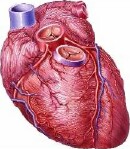Cardiac Artery Trouble Boosts Family Heart Risk
Relatives of those affected face higher odds of heart disease, study finds.
By Ed Edelson
HealthDay Reporter
|
E-mail this article
Subscribe to news
Printer friendly version
|

(SOURCES: Heribert Schunkert, M.D., head, cardiology, University of Luebeck, Germany; Dhananjay Vaidya, M.D., assistant professor, internal medicine, Johns Hopkins University, Baltimore; Oct. 4, 2007, European Heart Journal)
THURSDAY, Oct. 4 (HealthDay News) -- The close relatives of people who carry an abnormality in the heart's left main artery should take special care of their own cardiac health, experts say.
Healthy brothers and sisters of someone with such problems are 2.5 times more likely to develop some form of heart disease, compared to the siblings of patients with heart disease not related to that artery, concludes a report in the Oct. 4 issue of the European Heart Journal.
"We first reported a relationship two years ago," said Dr. Heribert Schunkert, head of cardiology at the University of Luebeck, Germany, and lead author of two reports in the journal. "This time, we specifically investigated the possibility of high heritability of the condition. That was the case."
In one report, Schunkert and his colleagues analyzed coronary angiograms from more than 1,800 members of families in which two or more people developed coronary artery disease. They found that 12 percent had a 50 percent or more narrowing of the left main coronary artery. According to Schunkert, that finding demonstrated that the problem clusters in families and that its cause was probably genetic.
The second study followed almost 1,400 healthy brothers and sisters of people with coronary artery disease for five years.
A left main coronary artery problem was found in 13.9 percent of those who developed heart disease but in only 6.4 percent of those who did not. The risk of developing heart disease was 2.5 times higher for brothers and sisters of someone with a left coronary artery than in those where the patient suffered from some other form of heart disease.
"The clinical implication is that if a person demonstrates a left main coronary artery problem, siblings should know that they have a greatly increased risk of coronary artery disease," Schunkert said.
Those family members might undergo screening to detect left main coronary artery problems, he said, although it is not clear whether the chance of preventing heart disease is high enough to justify the costs and risks of screening.
But the German studies do not necessarily show that problems with the left main coronary artery gives relatives any more reason be concerned, said Dr. Dhananjay Vaidya, an assistant professor of internal medicine at the Johns Hopkins University in Baltimore.
Because a family history of heart disease is a known risk factor for heart trouble, "brothers and sisters of someone with any heart disease should take it seriously," said Vaidya, who is also a member of the team conducting the Sibling Family Heart Study.
The Sibling Family Heart Study has enrolled more than 700 family members of people treated for heart attacks in Baltimore hospitals. Researchers are following them to detect "whether persons present with the same kind of heart disease as their close relatives," Vaidya said.
There is particular reason to worry when the left main coronary artery is affected, since it supplies about two-thirds of the heart's blood flow, Vaidya said. But the German studies showed that this was a relatively rare condition, and the data on its heritability was not conclusive, he said.
It's possible that the Baltimore study may now be changed slightly "to determine if there is something biologically special about left main coronary artery disease," Vaidya said.
More information
The role of family history in the various risk factors for heart disease is explained by the American Heart Association. 
Copyright © 2007 ScoutNews, LLC. All rights reserved. 
HealthDayNews articles are derived from various sources and do not reflect federal policy. healthfinder.gov does not endorse opinions, products, or services that may appear in news stories. For more information on health topics in the news, visit the healthfinder.gov health library.